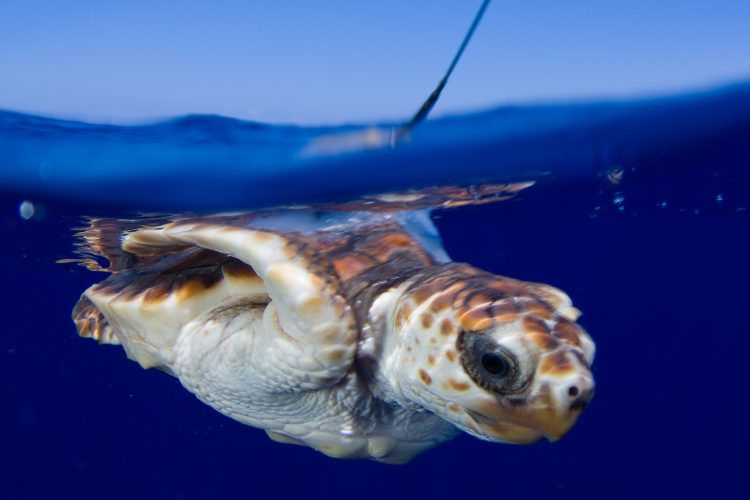Researcher Unravels Mystery of Sea Turtles’ ‘Lost Years’

Photo credit: Jim Abernethy A neonate sea turtle with tracking device attached to its shell makes its way in Atlantic waters.
The “lost years” refer to the time after turtles hatch and head out to sea until they are seen again upon returning to near-shore waters as large juveniles. The time at sea is often called the “lost years” because not much has been known about where the young turtles go and how they interact with their oceanic environment, until now.
With small, non-invasive, solar-powered satellite transmitters attached to the turtles’ shells, Wyneken and the team were able to track 17 neonate loggerhead sea turtles for periods ranging from 27 to 220 days and for distances ranging from 124 miles to 2,672 miles.
“Prior to tagging these threatened sea turtles, all we knew about this part of their life’s journey came from one turtle that had been followed for three days,” Wyneken said. “From the time they leave our shores, we don’t hear anything about them until they are found near the Canary Islands. Those waters are a bit like nursery school for them, as they stay for about four to eight years. There’s a whole lot that happens crossing the Atlantic that we knew nothing about.”
Along with Wyneken and Mansfield, Warren P. Porter, Ph.D., from the University of Wisconsin Madison, and Jiangang Luo, from the University of Miami, found that some of their results challenge previously held beliefs.
While the turtles remain in oceanic waters off the Continental Shelf, the study found that little loggerhead turtles sought the surface of the water as predicted. But they do not necessarily remain within the major currents associated with the North Atlantic Subtropical Gyre. It was historically thought that loggerhead turtles hatching from Florida’s east coast complete a long, developmental migration in a large circle around the Atlantic entrained in these currents. But the team’s data suggest that turtles may drop out of these currents into the middle of the Atlantic or the Sargasso Sea.
The team also found that the turtles mostly stayed at the sea surface, where they were exposed to the sun’s energy, and the turtles’ shells registered more heat than anticipated (as recorded by sensors in the satellite tags), leading the team to consider a new hypothesis about why the turtles seek refuge in Sargassum, a type of seaweed found on the surface of the water in the deep ocean. Sargassum is a habitat long associated with young sea turtles.
“We propose that young turtles remain at the sea surface to gain a thermal benefit,” Mansfield said. “This makes sense because the turtles are cold blooded animals. By remaining at the sea surface, and by associating with Sargassum habitat, turtles gain a thermal refuge of sorts that may help enhance growth and feeding rates, among other physiological benefits.”
Wyneken and Mansfield are currently working under grants from NOAA, Florida Sea Turtle License Plate fund, Save Our Seas Foundation, and several individual donors to conduct further work on the sea turtle “lost years.”
“Our satellite tracks help define Atlantic loggerhead nursery grounds and early loggerhead habitat use,” said Wyneken. “This allows us to reexamine the sea turtle ‘lost years’ paradigms.”
For more information, contact Jeanette Wyneken at 561-297-0146 or jwyneken@fau.edu.
-FAU-
About Florida Atlantic University:
Florida Atlantic University, established in 1961, officially opened its doors in 1964 as the fifth public university in Florida. Today, the University, with an annual economic impact of $6.3 billion, serves more than 30,000 undergraduate and graduate students at sites throughout its six-county service region in southeast Florida. FAU’s world-class teaching and research faculty serves students through 10 colleges: the Dorothy F. Schmidt College of Arts and Letters, the College of Business, the College for Design and Social Inquiry, the College of Education, the College of Engineering and Computer Science, the Graduate College, the Harriet L. Wilkes Honors College, the Charles E. Schmidt College of Medicine, the Christine E. Lynn College of Nursing and the Charles E. Schmidt College of Science. FAU is ranked as a High Research Activity institution by the Carnegie Foundation for the Advancement of Teaching. The University is placing special focus on the rapid development of three signature themes – marine and coastal issues, biotechnology and contemporary societal challenges – which provide opportunities for faculty and students to build upon FAU’s existing strengths in research and scholarship. For more information, visit www.fau.edu
Media Contact
All latest news from the category: Ecology, The Environment and Conservation
This complex theme deals primarily with interactions between organisms and the environmental factors that impact them, but to a greater extent between individual inanimate environmental factors.
innovations-report offers informative reports and articles on topics such as climate protection, landscape conservation, ecological systems, wildlife and nature parks and ecosystem efficiency and balance.
Newest articles

Properties of new materials for microchips
… can now be measured well. Reseachers of Delft University of Technology demonstrated measuring performance properties of ultrathin silicon membranes. Making ever smaller and more powerful chips requires new ultrathin…

Floating solar’s potential
… to support sustainable development by addressing climate, water, and energy goals holistically. A new study published this week in Nature Energy raises the potential for floating solar photovoltaics (FPV)…

Skyrmions move at record speeds
… a step towards the computing of the future. An international research team led by scientists from the CNRS1 has discovered that the magnetic nanobubbles2 known as skyrmions can be…





















